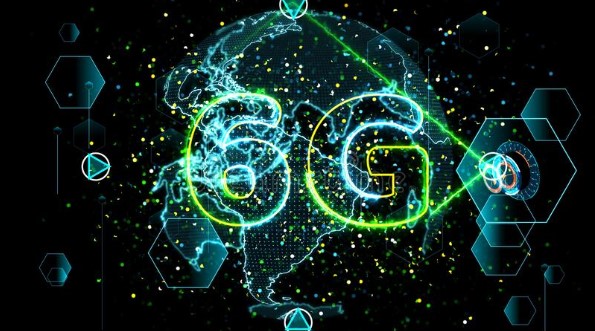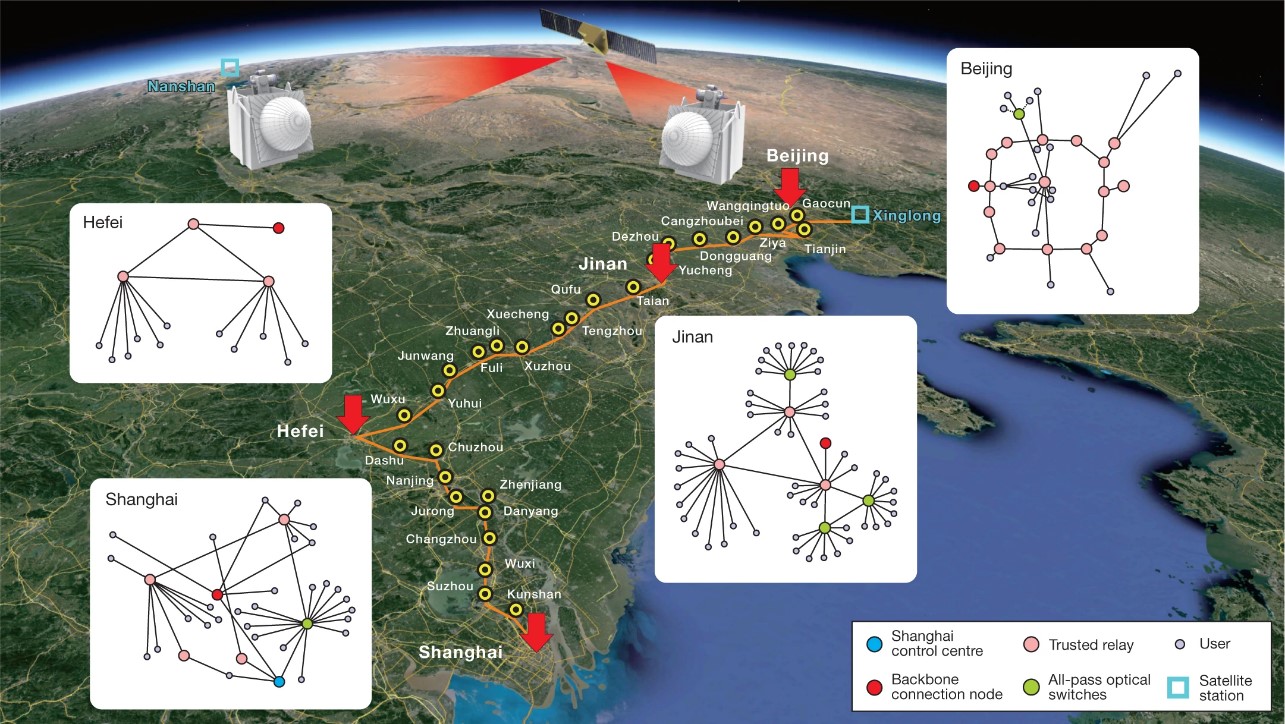热点论文与带您领略5G/6G领域热点研究的最新进展——图书馆前沿文献专题推荐服务(38)
2021-04-20

在上一期前沿文献中推荐中,介绍了5 G/6G基础研究的最新进展,选取的文献包括:一种基于数字超表面空分及频分复用的无线通信方案、用于动态可调谐毫米波超材料移相器的空气桥肖特基二极管、通往6G之路-通信工程师面临的十大物理层挑战、以及网络模拟器在机器学习辅助5G/6G网络中的应用。
在本期的文献推荐中,继续介绍5G/6G领域热点研究的最新进展,包括:卫星通信使用的X波段反射阵列天线的研制,传输距离在4600公里以上的综合星-地量子通信网,通过有效的CSIT限制方案实现6G时代的超低延迟、低能耗和大规模应用,以及面向端到端的全栈6G太赫兹网络,供相关领域的科研人员参考。
领域一 卫星通信使用的X波段反射阵列天线的研制
Development of an X-Band Reflectarray Antenna for Satellite Communications
Bing Ma, etc.
Scientific Reports, 2021
An X-band reflectarray antenna using 16 × 12 double square ring elements for satellite communications is proposed in this paper. The feed is a 4 × 3 elements microstrip patch array designed to create edge taper of approximately − 10 dB. A prototype with right-hand circular polarization (RHCP) is manufactured and tested, and the good agreements between simulations and measurements are demonstrated. The good performance is obtained with the aperture efficiency of 40.7% and the 3-dB gain bandwidth of about 10% which is beneficial to nanosatellites.
领域二 传输距离在4600公里以上的综合星-地量子通信网
An integrated space-to-ground quantum communication network over 4,600 kilometres
Yu-Ao Chen, etc.
Nature, 2021, 589: 214–219
Quantum key distribution (QKD) has the potential to enable secure communication and information transfer. In the laboratory, the feasibility of point-to-point QKD is evident from the early proof-of-concept demonstration in the laboratory over 32 centimetres4; this distance was later extended to the 100-kilometre scale with decoy-state QKD and more recently to the 500-kilometre scale with measurement-device-independent QKD. Several small-scale QKD networks have also been tested outside the laboratory. However, a global QKD network requires a practically (not just theoretically) secure and reliable QKD network that can be used by a large number of users distributed over a wide area. Quantum repeaters could in principle provide a viable option for such a global network, but they cannot be deployed using current technology. Here we demonstrate an integrated space-to-ground quantum communication network that combines a large-scale fibre network of more than 700 fibre QKD links and two high-speed satellite-to-ground free-space QKD links. Using a trusted relay structure, the fibre network on the ground covers more than 2,000 kilometres, provides practical security against the imperfections of realistic devices, and maintains long-term reliability and stability. The satellite-to-ground QKD achieves an average secret-key rate of 47.8 kilobits per second for a typical satellite pass—more than 40 times higher than achieved previously. Moreover, its channel loss is comparable to that between a geostationary satellite and the ground, making the construction of more versatile and ultralong quantum links via geosynchronous satellites feasible. Finally, by integrating the fibre and free-space QKD links, the QKD network is extended to a remote node more than 2,600 kilometres away, enabling any user in the network to communicate with any other, up to a total distance of 4,600 kilometres.

领域三 通过有效的CSIT限制方案实现6G时代的超低延迟、低能耗和大规模应用
Ultra-Low Latency, Low Energy, and Massiveness in the 6G Era via Efficient CSIT-Limited Scheme
Onel L. A. Lopez, etc
IEEE Communications Magazine, 2020, 58(11): 56-61
Channel state information (CSI) has been a key component in traditional wireless communication systems. This might no longer hold in future networks supporting services with stringent quality of service constraints such as extremely low latency, low energy, and/or large number of simultaneously connected devices, where acquiring CSI would become extremely costly or even impractical. We overview the main limitations of CSI at the transmitter side (CSIT)-based designs toward the 6G era, assess how to design and use efficient CSIT-limited schemes that allow meeting the new and stringent requirements, and highlight some key research directions. We delve into the ideas of efficiently allocating pilot sequences, relying on statistical CSIT and/or using location-based strategies, and demonstrate viability via a selected use case.
领域四 面向端到端的全栈6G太赫兹网络
Toward End-to-End, Full-Stack 6G Terahertz Networks
Michele Polese, etc.
IEEE Communications Magazine, 2020, 58(11): 48-54
Recent evolutions in semiconductors have brought the terahertz band into the spotlight as an enabler for terabit-per-second communications in 6G networks. Most of the research so far, however, has focused on understanding the physics of terahertz devices, circuitry, and propagation, and on studying physical layer solutions. However, integrating this technology in complex mobile networks requires proper design of the full communication stack, to address link- and system-level challenges related to network setup, management, coordination, energy efficiency, and end-to-end connectivity. This article provides an overview of the issues that need to be overcome to introduce the terahertz spectrum in mobile networks, from a MAC, network, and transport layer perspective, with consideration on the performance of end-to-end data flows on terahertz connections.
往期精彩推荐
前沿论文带您解读5G应用领域 ——图书馆前沿文献专题推荐服务(2)
热点论文解读AI应用领域 ——图书馆前沿文献专题推荐服务(3)
热点论文带您探究5G和未来通信——图书馆前沿文献专题推荐服务 (4)
前沿文献带您解读自然语言处理技术 ——图书馆前沿文献专题推荐服务(5)
热点论文带您探究5G和未来通信材料技术领域 ——图书馆前沿文献专题推荐服务(6)
热点论文解读AI应用领域 ——图书馆前沿文献专题推荐服务(3)
热点论文带您探究5G和未来通信——图书馆前沿文献专题推荐服务 (4)
前沿文献带您解读自然语言处理技术 ——图书馆前沿文献专题推荐服务(5)
热点论文带您探究5G和未来通信材料技术领域 ——图书馆前沿文献专题推荐服务(6)
热点文献带您关注AI情感分类技术 ——图书馆前沿文献专题推荐服务(7)
热点论文带您探究6G的无限可能——图书馆前沿文献专题推荐服务(8)
热点文献带您关注AI文本摘要自动生成 ——图书馆前沿文献专题推荐服务(9)
热点论文:5G/6G引领社会新进步——图书馆前沿文献专题推荐服务(10)
热点文献带您关注AI机器翻译 ——图书馆前沿文献专题推荐服务(11)
热点论文与您探讨5G/6G网络技术新进展——图书馆前沿文献专题推荐服务(12)
热点文献带您关注AI计算机视觉 ——图书馆前沿文献专题推荐服务(13)
热点论文与带您领略5G/6G的硬科技与新思路 ——图书馆前沿文献专题推荐服务(14)
热点文献带您关注AI计算机视觉 ——图书馆前沿文献专题推荐服务(15)
热点论文带您领略5G/6G的最新技术动向 ——图书馆前沿文献专题推荐服务(18)
热点文献带您关注图神经网络——图书馆前沿文献专题推荐服务(19)
热点论文与带您领略5G/6G材料技术的最新发展——图书馆前沿文献专题推荐服务(20)
热点文献带您关注模式识别——图书馆前沿文献专题推荐服务(21)
热点论文与带您领略6G网络技术的最新发展趋势 ——图书馆前沿文献专题推荐服务(22)
热点文献带您关注机器学习与量子物理 ——图书馆前沿文献专题推荐服务(23)
热点论文与带您领略5G/6G通信器件材料的最新进展 ——图书馆前沿文献专题推荐服务(24)
热点文献带您关注AI自动驾驶——图书馆前沿文献专题推荐服务(25)
热点论文与带您领略5G/6G网络安全和技术的最新进展——图书馆前沿文献专题推荐服务(26)
热点文献带您关注AI神经网络与忆阻器——图书馆前沿文献专题推荐服务(27)
热点论文与带您领略5G/6G电子器件和太赫兹方面的最新进展——图书馆前沿文献专题推荐服务(28)
热点文献带您关注AI与机器人——图书馆前沿文献专题推荐服务(29)
热点论文与带您领略5G/6G热点技术的最新进展——图书馆前沿文献专题推荐服务(30)
热点文献带您关注AI与触觉传感技术——图书馆前沿文献专题推荐服务(31)
热点论文与带您领略5G/6G热点技术的最新进展——图书馆前沿文献专题推荐服务(32)
热点文献带您关注AI深度学习与计算机视觉——图书馆前沿文献专题推荐服务(33)
热点论文与带您领略未来通信的热点技术及最新进展——图书馆前沿文献专题推荐服务(34)
热点文献带您关注AI强化学习——图书馆前沿文献专题推荐服务(35)
热点论文与带您领略5G/6G基础研究的最新进展——图书馆前沿文献专题推荐服务(36)
热点文献带您关注AI与边缘计算——图书馆前沿文献专题推荐服务(37)